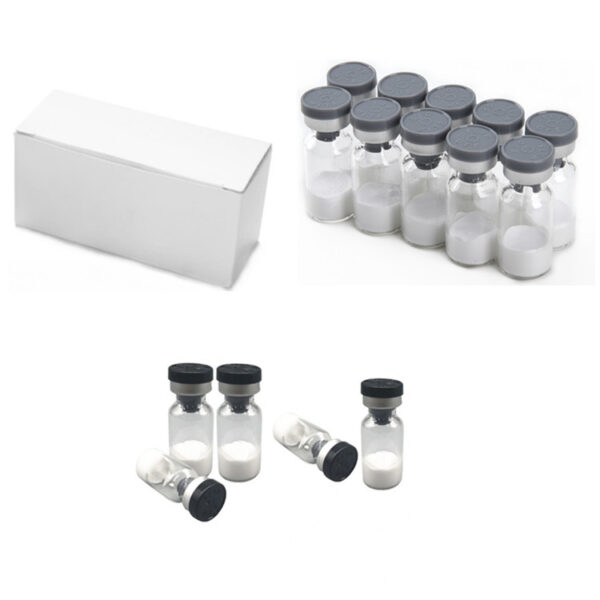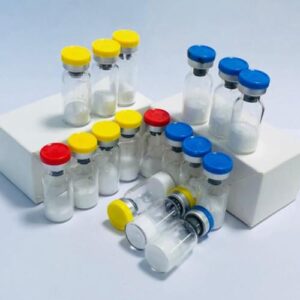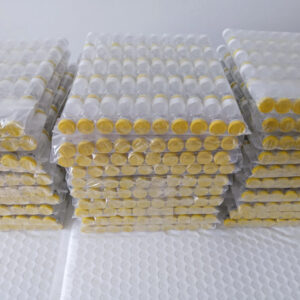Table of Contents
GDF-8 Briefing:
Product Name | GDF-8 |
Chemical Name | Growth Differentiation Factor 8 |
Other Names | Myostatin |
CAS | 901758-09-6 |
MF | C221H366N72O67S |
Appearance | White powder |
Dry | Freeze |
Purity | >98% |
GDF-8 Description:
Myostatin (also known as growth differentiation factor 8, abbreviated GDF-8) is a myokine, a protein produced and released by myocytes that acts on muscle cells’ autocrine function to inhibit myogenesis: muscle cell growth and differentiation. In humans it is encoded by the MSTN gene. Myostatin is a secreted growth differentiation factor that is a member of the TGF beta protein family.
Animals either lacking myostatin or treated with substances that block the activity of myostatin have significantly more muscle mass. Furthermore, individuals who have mutations in both copies of the myostatin gene have significantly more muscle mass and are stronger than normal. Blocking the activity of myostatin may have therapeutic application in treating muscle wasting diseases such as muscular dystrophy.
GDF-8 (propeptide-Fc) is a muscle growth inhibitory factor muscle growth and development process. Muscle inhibin is present in the healing process of muscle, and its nature is the inhibition of muscleogenesis (muscle tissue formation process). Scientists have been researching a new method of enhancing the repair and regeneration of muscle and bone in some lesions by introducing recombinant myostatin peptides through new recombinant muscle.Myostatin / GDF-8 is a protein that in humans is encoded by the MSTN gene. It isproduced primarily in skeletal muscle cells, circulates in the blood and acts on muscle tissue. The myostatin propeptide is known to bind and inhibit myostatin in vitro. This interaction is relevant in vivo, with a majority (>70%) of myostatin in serum bound to its propeptide acting as a negative regulator of myostatin. Recombinant human Myostatin Propeptide is a non-glycosylated protein, containing 244 amino acids, with a molecular weight of 27.8 kDa. Our Myostatin 1mg is Tagged. The tags are chains/pile of amino acids/proteins, it is foreign protein that will cause immunization reaction in most cases.
Myostatin / GDF-8 is a member of the TGF beta superfamily of proteins. Human myostatin consists of two identical subunits, each consisting of 109 amino acid residues. Its total molecular weight is 25.0 kDa. The protein is made in an inactive form. For it to be activated, a protease cleaves the NH2-terminal, or “pro-domain” portion of the molecule, resulting in the now-active COOH-terminal dimer Myostatin (GDF-8) is a member of the transforming growth factor-beta (TGF-beta) superfamily that is highly expressed in skeletal muscle, and myostatin loss-of-function leads to doubling of skeletal muscle mass. Myostatin-deficient mice have been used as a model for studying muscle-bone interactions, and here we review the skeletal phenotype associated with altered myostatin signaling. It is now known that myostatin is a key regulator of mesenchymal stem cell proliferation and differentiation, and mice lacking the myostatin gene show decreased body fat and a generalized increase in bone density and strength.
The increase in bone density is observed in most anatomical regions, including the limbs, spine, and jaw, and myostatin inhibitors have been observed to significantly increase bone formation. Myostatin is also expressed in the early phases of fracture healing, and myostatin deficiency leads to increased fracture callus size and strength. Together, these data suggest that myostatin has direct effects on the proliferation and differentiation of osteoprogenitor cells, and that myostatin antagonists and inhibitors are likely to enhance both muscle mass and bone strength.
GDF-8 Application:
1. Treat muscle atrophy, strengthen muscle toughness,Increase muscle number.
2. Treating malnutrition patients is an important index of the strength training athletes.
3. GDF-8 can effectively prevent the increased due to age brings the increase of adipose tissue, and reduce the occurrence of diabetes.
The gene encoding myostatin was discovered in 1997 by geneticists Se-Jin Lee and Alexandra McPherron who produced a strain of mutant mice that lack the gene. These myostatin “knockout” mice have approximately twice as much muscle as normal mice. These mice were subsequently named “mighty mice”.
Naturally occurring deficiencies of myostatin have been identified in cattle by Ravi Kambadur, whippets, and humans; in each case the result is a dramatic increase in muscle mass. A mutation in the 3′ UTR of the myostatin gene in Texel sheep creates target sites for the microRNAs miR-1 and miR-206. This is likely to cause the muscular phenotype of this breed of sheep.
Human myostatin consists of two identical subunits, each consisting of 109 (NCBI database claims human myostatin is 375 residues long) amino acid residues. Its total molecular weight is 25.0 kDa. The protein is inactive until a protease cleaves the NH2-terminal, or “pro-domain” portion of the molecule, resulting in the active COOH-terminal dimer. Myostatin binds to the activin type II receptor, resulting in a recruitment of either coreceptor Alk-3 or Alk-4. This coreceptor then initiates a cell signaling cascade in the muscle, which includes the activation of transcription factors in the SMAD family – SMAD2 and SMAD3. These factors then induce myostatin-specific gene regulation. When applied to myoblasts, myostatin inhibits their differentiation into mature muscle fibers. myostatin has direct effects on the proliferation and differentiation of osteoprogenitor cells, and that myostatin antagonists and inhibitors are likely to enhance both muscle mass and bone strength.
Myostatin (GDF-8), a member of the TGFbeta superfamily, is a potent and specific negative regulator of skeletal muscle mass. In serum, myostatin circulates as part of a latent complex containing myostatin propeptide and follistatin-relatedgene.
The myostatin propeptide is known to bind and inhibit myostatin in vitro. This interaction is relevant in vivo, with a majority (>70%) of myostatin in serum bound to its propeptide. The myostatin propeptide is negative regulator of myostatin in vivo.
Animals either lacking myostatin or treated with substances that block the activity of myostatin have significantly more muscle mass. Furthermore, individuals who have mutations in both copies of the myostatin gene have significantly more muscle mass and are stronger than normal. Blocking the activity of myostatin may have therapeutic application in treating muscle wasting diseases such as muscular dystrophy.
Myostatin (GDF8) is expressed uniquely in human skeletal muscle as a 12 kDa mature glycoprotein consisting of 113 amino acid residues and secreted into plasma. Myostatin is a member of the transforming growth factor ß superfamily of secreted growth and differentiation factors that is essential for proper regulation of skeletal muscle mass. Studies have shown that myostatin could play an important role in cardiac development and physiology.
GDF-8 Dosage:
Doses of Myostatin propeptide have been tested mice and it has showed an optimal increase of muscle mass at a dose of 20 mg/kg. It can be used every 5 days during 25 five days.
GDF-8 COA:
Item | Specification | Result |
Appearance | White powder | Complies |
Identification | Positive | Complies |
Assay | 99.0% min | 99. 3% |
Loss on Drying | 6.0%max. | 4.80% |
Mass Balance | 95.0~105.0% | Complies |
Acetate Content (HPIC) | 12.0%max. | 10.80% |
Peptide Content (N%) | 80.0%min. | 88.00% |
Amino Acid Composition | ±10% of theoretical | Complies |
Single Impurity (HPLC) | 1.0%max. | 0.85% |
How to process the order?
- send us an email toinfo@bulkrawspharma.com with the following details: product names, quantity and your special requests (eg. need custom produced)
- we quote and confirm your request details
- we ship your order after payment done and offer tracking code & packing pictures within 1-3 days
- we will keep you updated of your order status
- order received and review our services
Payment terms
MoneyGram, Western Union, Bitcoin,T/T Bank transfer,USDT.escrow alibaba (credit card,paypal),etc.









Reviews
There are no reviews yet.